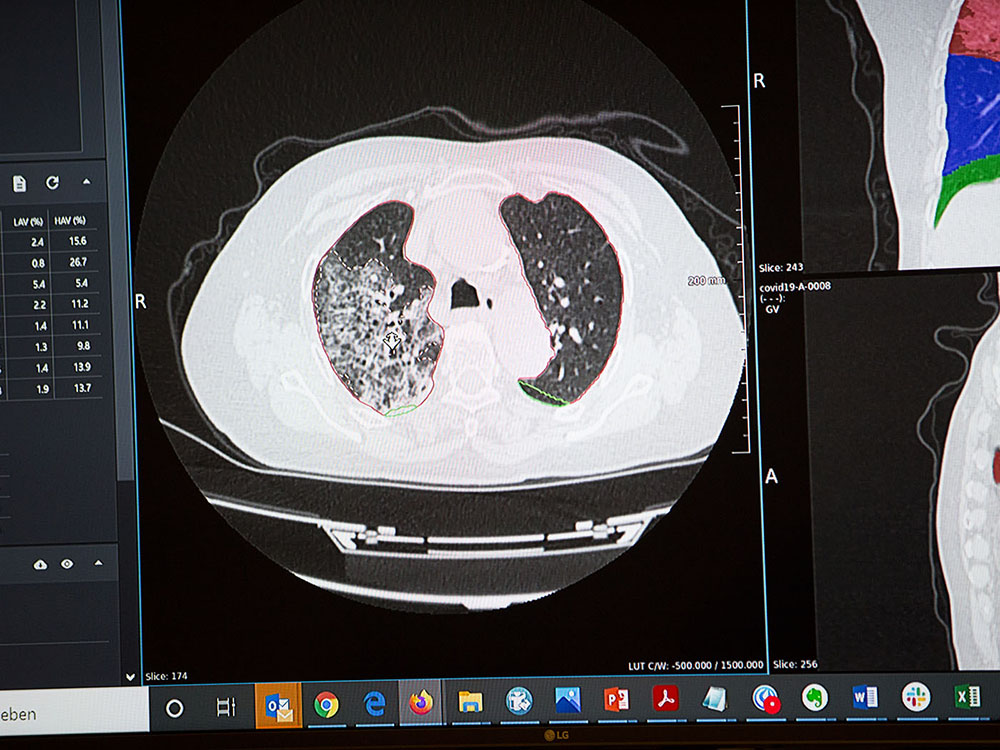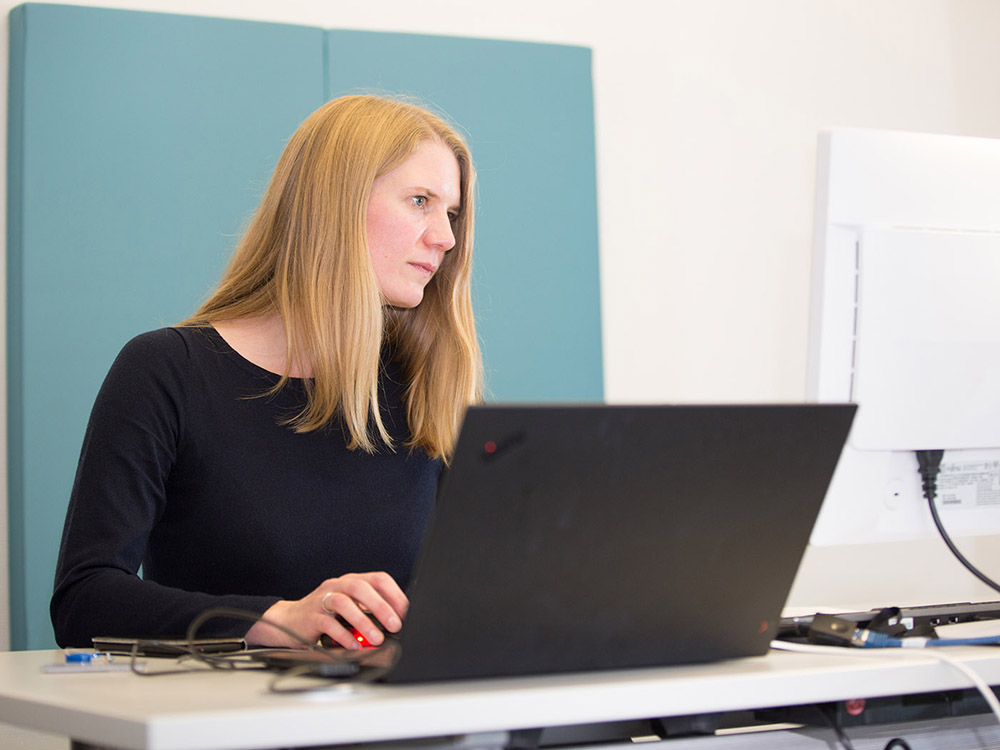
© Jens Lehmkühler / U Bremen Research Alliance
Fighting COVID-19 More Effectively
The initiative NFDI4Health Task Force COVID-19 is developing a national information and consultation structure for health data.
In the fight against the virus, a great deal would be better if the data that is being used and produced by science were easier to find, standardized, and connectable. This is exactly what the Task Force COVID-19 in the U Bremen Research Alliance is trying to do. “It is not findings that we wish to provide,” says Prof. Dr. Iris Pigeot, task force coordinator and vice president of the U Bremen Research Alliance. “We want to offer the structures so that findings can be made.” 48 renowned institutions are involved in the National Research Data Infrastructure for personal health data.
Prof. Dr. Hajo Zeeb does not have a great deal of time. The epidemiologist just gave an interview for Sky News and the next video conference is waiting. The need for information on COVID-19 is immense.

© Jens Lehmkühler / U Bremen Research Alliance
It is not always the case that studies on the same topic are comparable. There is some friction loss when it comes to the conception and realization. “Regardless of whether surveys or methodology – not everything needs to be reinvented,” says Zeeb, head of the Prevention and Evaluation Department at the Leibniz Institute for Prevention Research and Epidemiology (BIPS) in Bremen. “It would be wonderful if we had a central point of contact with information on the studies and a joint instrument case. That would make many things simpler.”
“We want to make it possible that substantial and rapid information about relevant research results is provided to the specialist community.”
There will be such a platform. The initiative with the name NFDI4Health Task Force COVID-19 is developing a national information and consultation structure for health data. “We want to make it possible that substantial and rapid information about relevant research results is provided to the specialist community,” is what Prof. Dr. Iris Pigeot, Task Force coordinator and director of BIPS, says when describing one of the aims. The platform is part of the National Research Data Infrastructure for personal health data, NFDI4Health in short. The government and states are funding the establishment of NFDI4Health with around 12 million euros and 48 renowned institutions are involved.
It should be “FAIR”, which is often too seldom the case. The term stands for the four principles of sustainable research data management: Findable, Accessible, Interoperable, and Reusable. The data, which is to be collected by the various agents in the health sector – thus health insurance companies, university hospitals, or researchers – is to follow all four principles.

© Jens Lehmkühler / U Bremen Research Alliance
One of the first jobs for BIPS in cooperation with the University Medical Center in Greifswald is the establishment of a comprehensive inventory of all German studies on COVID-19. Researchers who wish to carry out a study on the psychosocial effects of a lockdown in the future for example, can find out with just a few clicks if such investigations have already been carried out and with which hypothesis and methodology it was done. That has not been possible to date.
“What is very important to me: In order to help people in the best way possible, we need a comprehensive picture of them and not only an excerpt,” explains Pigeot. The intelligent connecting of various information from diverse sources is therefore of utmost significant. “For example, one could recognize if the course of an illness is affected by medication that is currently being taken,” states Pigeot when explaining the approach.
“What is very important to me: In order to help people in the best way possible, we need a comprehensive picture of them and not only an excerpt.”
Age, gender, medical history, and much more – the protection of sensitive personal data is the top priority. Therefore, in order to potentially use the data, concepts for how it can be connected and protected are needed. These will also be developed by the task force. Information needs and data protection could be provided with an algorithm that analyzes the data and connects it without actually sending it. “That must all run much quicker than it is to date – at best within half a day,” states Pigeot. At the moment, it can take up to one and a half years until the authorization for data usage is ready.
The software developed by MEVIS turns 600 cross sections into three-dimensional images.
Alongside BIPS, numerous renowned institutions are involved in the task force, for example the Robert Koch Institute in Berlin and the University Medical Center Göttingen, as well as two other U Bremen Research Alliance members. “Bremen is in a great position in terms of research data management,” emphasizes Pigeot, who is a statistician. Dr. Benedikt Büchner, Professor of Civil Law, Health Law, and Medical Law at the University of Bremen, is involved as an expert for data protection. Additionally, the Fraunhofer Institute for Digital Medicine MEVIS, which is led by Prof. Dr.-Ing. Horst Hahn, is also a part of the network. “These cooperations are unbelievably important as they add to our competences,” says Pigeot. Whilst the BIPS is working on survey data, MEVIS is interested in image data, which is playing an ever-growing role in medical diagnostics.

© Jens Lehmkühler / U Bremen Research Alliance
Dr. Bianca Lassen-Schmidt shows how that works only a couple of hundred meters away from BIPS in a MEVIS meeting room. The COVID-19 disease that has been triggered by the virus can be seen as a grey shadow on the scan of lung that was taken with the help of computer tomography (CT). COVID-19 typically shows a special pattern – it spreads at the outer lung edge to all pulmonary lobes. Liquid forms there and an exchange of gas is thus only possible in a restricted manner.
Lassen-Schmidt is a computer scientist. Lungs, she says, are her passion. For a good ten years, she has been working on them and completed her PhD on the breathing organ. How ill are the lungs really? To what level is the patient affected? Does he or she need to be put on a ventilator? Is the medication working? “Information that can help to answer these questions can be derived from CT data. Said data is very useful for early detection, diagnosis, prognosis, and for therapy,” she underscores. The software developed by MEVIS can turn up to 600 cross sections into three-dimensional images, which are intended to help radiologists with their work. The images are quickly and automatically analyzed and the results are provided in a structured manner. The lung image analysis is available within only a few minutes. Thus, this is also all about data, and ensuring its usability and possibly improving it.

© Jens Lehmkühler / U Bremen Research Alliance
MEVIS has several work packages in the Task Force COVID-19. One focusses on the quality assurance of CT data. The available images are automatically checked and classified according to a traffic light system: From green to red – from very good image quality to unusable.
Another package centers on the concepts for machine learning with the help of heterogeneous training data in clinics. The image data available there is assessed using clinical parameters in order to help in answering special clinical questions. Yet, it never leaves the clinic. “In this way, we receive a great deal of information without actually moving the data,” says Lassen-Schmidt.
“We are making a blueprint for the handling of epidemiological data for future pandemic situations available.”
It is with great effort that the scientists are working of the integration and harmonization of the data. However, it is uncertain if the task force can still contribute to the successful fight against this particular virus. “We are making a blueprint for the handling of epidemiological data for future pandemic situations available,” says Pigeot. One thing is certain: The next pandemic will surely come.
More:
This article comes from Impact – The U Bremen Research Alliance science magazine
The University of Bremen and twelve non-university research institutes financed by the federal government cooperate within the U Bremen Research Alliance. Die Zusammenarbeit erstreckt sich über vier Wissenschaftsschwerpunkte und somit „Von der Tiefsee bis ins Weltall“. The joint work spans across four high-profile areas and thus from “the deep sea into space.” Twice per year, the Impact science magazine provides an exciting insight into the effects of cooperative research in Bremen.